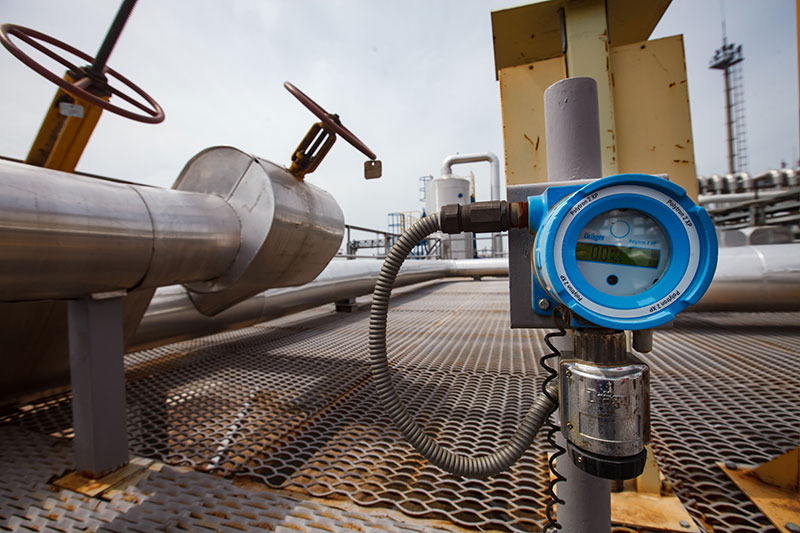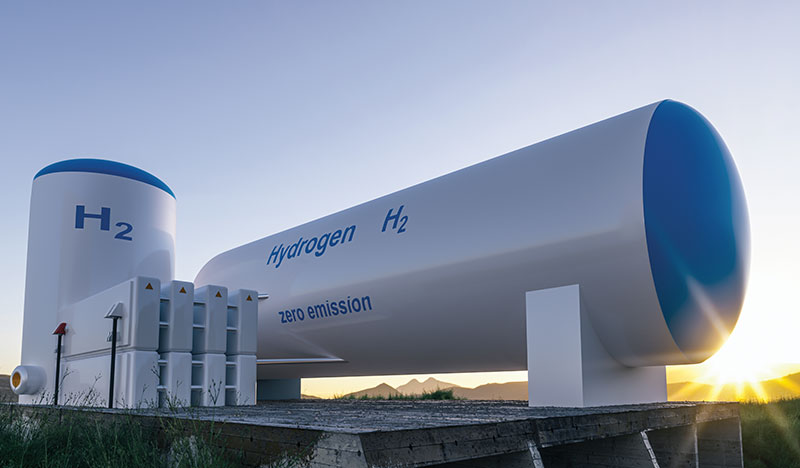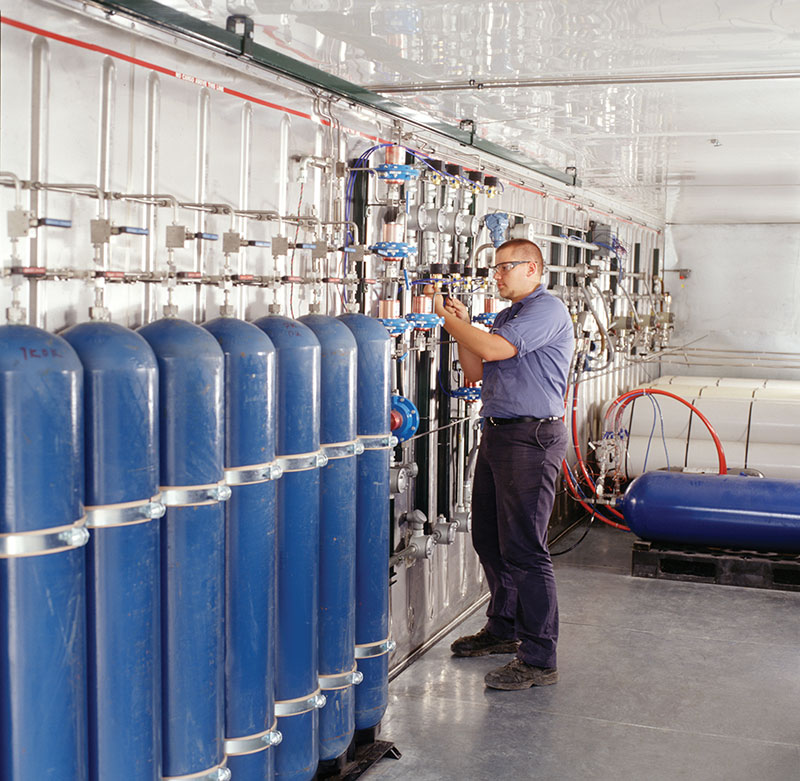December 2020, Vol. 247, No. 12
Features
Hydrogen: The Future Gas Energy Network
Delta, Utah, population 3,436, located about 100 miles (161 km) southwest of Salt Lake City, is not a place one would normally look for cutting-edge energy technology. It is the largest town in Millard County in the west-central part of the state and not far from the Topaz Relocation Center that interred Japanese-Americans during World War II.
Delta has long been known for the Intermountain Power Project (IPP), a massive municipal coal-fired generation plant that is being transformed into a 21st century energy project involving hydrogen and natural gas.
While sitting quietly over a massive salt dome cavern, IPP’s coal plant, whose largest customer is the city of Los Angeles, is taking on global interest these days as hydrogen is being considered more seriously as a partner in a decarbonized U.S. energy economy. Hydrogen can be derived by splitting the simple, abundant element from water (H2O) or methane (CH4).
The state-affiliated Independent Power Agency (IPA), electricity provider for 21 small municipal utilities in Utah, historically has supplied the Los Angeles Department of Water and Power (LADWP), which operated the IPP coal-fired plant and a 488-mile (785-km) direct current (DC) transmission line from Delta to Los Angeles.
This summer, IPA contracted with Japan’s global giant Mitsubishi-Hitachi Power Systems for the natural gas and hydrogen turbine system that will replace IPP’s coal units, a $2 billion part of the overall project that is being touted by industry and academic researchers as a major milestone promoting wider U.S. hydrogen use. University of California, Irvine (UCI), engineering professor Jack Brouwer, who also directs UCI’s National Fuel Cell Research Center, calls the Delta project the most significant project for demonstrating hydrogen’s potential in the West over the next five years.
At a virtual investors conference in September, Vancouver, British Columbia-based Ballard Power Systems’ CEO Ryan MacEwen predicted a growing expansion of the technology for hydrogen from expanding excess supplies of renewable-produced electricity. “The United States, and particularly the Southwest, has tremendous renewable resources as well as a tremendous capacity to produce hydrogen,” MacEwen said on the webcast.
This summer, Southern California Gas Co. (SoCalGas), the largest U.S. gas distributor, began producing near-carbon-free electricity for two of its largest Los Angeles-area facilities with fuel cell microgrids that operate on fossil natural gas, renewable natural gas (RNG) and hydrogen.
In play is the eventual conversion of the 1,800-MW IPP coal-fired plant during the next five years to create an 840-MW power plant fueled, at first, by a mix of 30% hydrogen and 70% natural gas with the intention of phasing in more hydrogen over two decades, resulting in a 100% hydrogen-fueled plant by 2045. Green hydrogen and other solar- and wind-produced electricity would be transported into the Los Angeles Basin via LADWP’s DC transmission line. The LA municipality is the operator of the current coal-fired plant and is the designated operator of the proposed hydrogen- and natural gas-fueled plant.
A project of this scale is just the kind that interests the newly formed national Green Hydrogen Coalition, according to its Executive Director Laura Nelson, a former energy advisor to Utah Gov. Gary Herbert. “Projects like IPP allow us to leverage other hydrogen projects in multisector applications,” Nelson said. “That’s exactly what is supposed to happen at the IPP project – large production, large off-take, repurposing a lot of infrastructure and jobs, and nearby salt domes that can be engineered to store hydrogen [up to 150,000 MWh].”
Nelson thinks some of the hydrogen eventually can go into other applications besides power production. “It is really the only project like it in the world,” she said. “I think it is a game-changer, for sure.”
An ongoing motivator for Nelson and others working in the hydrogen space these days is the abundance of new scalable solar and wind power projects. This increasingly adds to the imbalances on the grid, increasing the need for a means to smooth out loads, and hydrogen is a carbon-free solution to the growing problem in managing U.S. grids.
“You can make up for it with batteries when you only need to make up for a few hours, but when you have days, weeks or months, you need a long-duration energy storage, and green hydrogen is a way to provide that storage,” Nelson said.
From what he calls “objective analysis and rigorous evaluation,” UCI’s Brouwer said that by applying the scientific method to price and technology changes, along with historical trends for wind, solar and batteries, “we will be able to make renewable hydrogen from bio and sun/wind resources and transport it around society.
So, that would basically introduce a hydrogen-based energy economy. And he thinks it can produce costs that are cheaper than current infrastructure costs for petroleum, natural gas and coal.
“When we move in this direction, the cost curves suggest it will be cheap,” Brouwer said. “And certainly, it’ll be cheaper than the alternatives that would allow the same amounts of sun and wind power to be used. The things you can do with hydrogen, you can’t do with electricity and batteries.”

On a second-quarter 2020 earnings conference call, San Diego, Calf.-based natural gas infrastructure holding company Sempra Energy’s CEO Jeff Martin talked up both gas and hydrogen in the context of electrification around the nation, arguing that natural gas will play a long-term role in energy policy.
“Remember that with electrification, more likely than not you’re going to need two or three or four times the electricity, and that will require more gas for power production,” Martin told his earnings call audience. Longer term, hydrogen as a fuel is at a high level of interest, he added, noting that Sempra is looking at up to 10 different projects using hydrogen in transportation, blending opportunities in power generation, blending in compressor stations at its SoCalGas utility subsidiary, and injecting cost-savings and efficiency in existing facilities, such as liquefied natural gas (LNG) projects.
A partner with hydrogen trade organizations and nations overseas, including Japan and Germany, Sempra is “quite bullish on hydrogen and renewable natural gas, particularly in California,” Martin said. “For the energy transition that is facing our sector and globally, hydrogen is going to play an increasingly important role. It is still a little bit early, but it is time now for us to establish a leadership position.”
Sempra’s Group President Kevin Sagara, who was CEO of Sempra’s other California utility, San Diego Gas and Electric Co., also is bullish about hydrogen prospects. His company, he said, has an edge in California, which “has always led the way in clean energy … in this regard, I expect it will be no different. We see opportunities in our own system” for industry and transportation in which hydrogen could “play a key role, and we would expect our infrastructure to be right in the middle of it.”
Regarding the economics for commercial-scale hydrogen, Martin cited the commercial viability trendline for solar photovoltaics and predicted the same cost reductions would happen to hydrogen. “A lot will depend on the advances on the research and development [R&D] side … to costs in the forward curve.”
While there is plenty of optimism for hydrogen in these carbon-conscious days, reality also indicates that, as Martin said, a lot more R&D is in order to tighten up the technical side and improve the economics. Industry R&D centers like the Illinois-based GTI are looking at hydrogen broadly, including technology development on production and generation, integration into the existing gas pipeline infrastructure and various other applications such as power generation, transportation and heavy industries.
There have been a number of GTI studies on integration of hydrogen into the U.S. gas grid and/or local distribution systems. Initially, a number of years ago, GTI looked at various low concentrations of hydrogen-gas mixes. Those studies looked at the impact on general pipeline structure and materials.
“There are still a lot of R&D and technical issues regarding high-hydrogen blends that we need to work out,” said Kristine Wiley, executive director of GTI’s hydrogen technology center in suburban Chicago. “There are about 1,600 miles of hydrogen-dedicated pipelines, mostly around the Texas Gulf of Mexico region. As we start moving closer to decarbonization, hydrogen will play a big role in the transformation. It promises to be a key technology and pathway toward the decarbonization of our economy. That is partially why we created the hydrogen center.”
In steel pipelines there are concerns of hydrogen causing embrittlement, leaks or deterioration in the pipe. GTI has also looked at low hydrogen percentages – 5 – in plastic distribution pipe. “Based on our testing, the plastic performed within its recognized limits,” Wiley said. “When it comes to steel there is a lot more testing and validation that needs to be done.”
At the Virginia-based Pipeline Research Council International (PRCI), researchers have been examining hydrogen as a serious pursuit since 1972, looking to find ways to make it a ubiquitous energy source similar to natural gas. In the fall of 2020, PRCI is set to release a “state-of-the-art analysis” to define all of the additional research projects needed to allow the safe, reliable injection of hydrogen into existing gas pipelines at blended levels with hydrogen.
It is a study involving more than 30 organizations globally with worldwide implications for the future expanded use of hydrogen as a carbon-free energy component.
Historically, PRCI, which at one time was part of the American Gas Association before breaking off as an independent nonprofit research center in 2000, has done substantial work on embrittlement and stress cracking in pipelines as caused by hydrogen transportation. In 1972, PRCI research was focused on hydrogen supplementing the then-dwindling U.S. natural gas supplies.
PRCI President Cliff Johnson calls hydrogen “an interesting new opportunity” for which his international research organization is “exploring the areas of research needed to ensure safe transportation of this product.”
“Obviously, times have changed, and hydrogen is a greener fuel than natural gas,” said Gary Choquette, PRCI’s executive director for research and IT, calling out the ongoing study of all aspects of transporting blends of hydrogen and natural gas. “This study is multiorganizational and multinational. What the study boils down to is identifying the remaining research gaps that need to be filled to safely and reliably transport hydrogen and natural gas and determine currently who is working on what parts of the research needs.”
Choquette and PRCI are quick to point out the distinct differences between hydrogen gas and natural gas. Hydrogen is less dense, has a lower heat rate, lacks a good odorant, has a lower ignition and has a wider range of flammability.
UCI professor Brouwer said, “You have to know that hydrogen is going to behave differently, and with this knowledge, the systems can be just as easily engineered to be as safe as a natural gas system.”
He teaches an engineering course on the differences between hydrogen and all the fuels transported today.
“If there is a large proportion of hydrogen in the pipeline system, the total capacity of the pipeline system will be reduced, and there has been no research done on this,” Choquette said. “In bright light, hydrogen is invisible, so you could walk into a hydrogen flame and not know it.”
In this year’s state-of-the-art analysis by PRCI, there was no assessment of the economics of massive hydrogen use and specific end uses. The research center is focused on the transportation side exclusively.
“The results will apply to any gas pipeline system and any utility systems,” Choquette said. “The Europeans, in general, are way ahead of us; there are portions of Europe that are already transporting hydrogen in places like the Netherlands and Germany. They are up in the Baltic region, where there is a lot of excess offshore wind power.
“A given is that the more hydrogen you inject into a pipeline, the more total capacity you lose in that line,” he said. “I don’t think it is on the radar of the people arguing for hydrogen to replace natural gas. After all, to deliver 100% hydrogen in the same volumes as natural gas, you would need added capacity because of the difference in density. There is a strong push to go to a green energy system with natural gas now as the bridge, and both renewable natural gas and hydrogen are going to play big roles in that effort.”
UCI’s Brouwer said researchers know that some of the steel pipelines in the gas system would be susceptible to hydrogen embrittlement or enhanced fatigue crack growth rates. “This is a known phenomenon of hydrogen because it is such a small molecule and can get into cracks and embrittle the metal to the point where it could eventually fail,” he said.
So, one of the things that must be done, Brouwer thinks, if hydrogen is introduced into the natural gas network, is to investigate the embrittlement impact. Brouwer’s center has assessed the Sempra Energy/SoCalGas system, the nation’s largest utility transmission/distribution pipeline system, looking at its field pipelines and pressure dynamics. The work has suggested that it is “a pretty manageable problem,” he said. “Embrittlement takes a very long time to actually lead to failure, and as a result, regular maintenance and replacement of pipe for natural gas could be sufficient for managing the problem on maybe a slightly accelerated replacement schedule.”
Brouwer said with only small amounts (5%-20%) of hydrogen the problem of embrittlement is definitely manageable. “If you’re introducing mixtures, I don’t think it is going to be a problem,” he said, noting that the “tightest” constraints are related to end uses of the mixed fuel.
In most cases, Brouwer said, 20% hydrogen is fine, but in some end uses it is not as good to be that high, such as residential appliances, natural gas vehicles (NGV) and other end uses. “Most people think you can go up to 20% with most end uses without any really big investment in [upgraded] infrastructure,” he said. “Then, you need to design the system piecewise or by sections, but if you want to go a step further to 100% pure hydrogen, you need to assign that to a separate section of the system and segregate it from the rest of the network.
Hydrogen can be massively stored in salt caverns, and that is what is done with the existing hydrogen pipeline network along the Gulf Coast, from Texas to Florida. Salt cavern storage is serving those pipes along the Gulf Coast, Brouwer notes. “We’re not so sure that the depleted oil and gas fields used for gas storage in California, for example, can handle hydrogen. There are research problems in making sure they don’t leak, or possibly react with some of the oil remnants, and even biological activity that may be different with hydrogen.”
There are a number of R&D questions that need to be answered before hydrogen can be stored in depleted oil/gas fields. The long-term safety and economic viability are some of those questionable areas. Hydrogen is quite universal and particularly applicable to large urban areas, Brouwer said, which is in contrast to renewables that must be sited outside urban areas with the power transported in via expensive transmission infrastructure. In the densely populated Northeastern corridor, gas systems supported by fuel cells kept the lights on when recent hurricane-spawned tropical storms knocked out utility power grids for long periods.
Ultimately, longer duration storage is going to be necessary to get to 100% carbon-free energy. Renewables with batteries will only bring the United States 60% to 70% of the way, Brouwer maintains. “It is going to be demand at a massive scale for introducing renewables into difficult applications and at high levels on the electric grid,” he said.
“There is no other known solution for doing those things. We haven’t yet forced ships or trains or long-haul trucks or heavy industry to go to zero emissions, and I think that is good that we haven’t taken those steps yet. It’s much better for them to use [liquefied] natural gas [LNG] as a short-term strategy. Once we start cracking down on those applications and we need long-term storage on the grid, hydrogen is going to end up being cheap.”
Either by “design or luck,” economies around the world are investing in wind and solar, but they haven’t invested much in hydrogen, Brouwer said.
“Nevertheless, they’re all coming around to understand that hydrogen fits in the later years of the transition off fossil fuels,” he added. “That’s exactly what is happening. That’s why there have been hundreds of billions of dollars invested in solar and batteries in China. That has brought the cost of batteries down tremendously. Now they are investing in hydrogen, and so is Germany, Japan and the U.K.”







Comments